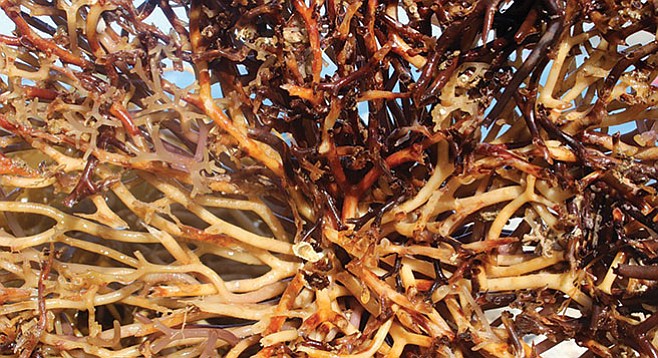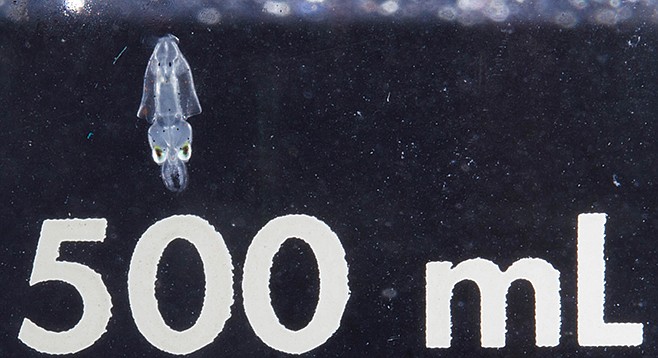 Facebook
Facebook
 X
X
 Instagram
Instagram
 TikTok
TikTok
 Youtube
Youtube

I was walking on the beach recently with a visiting Wisconsonite, giving the requisite talk about our giant kelp and the ecosystem it supports, when we made a peculiar find. In the sand near a washed-up holdfast — a kelp’s anchoring tangle of rootlike haptera — lay a fingerlike gelatinous white blob. Upon closer inspection, I leapt to my feet and did a sea geek’s jig, prancing frantically around the beach in search of an empty bottle. Finding one, I filled it with seawater, dropped the blob in, and held it close to my friend’s face until her eyes, too, lit up. We had found a squid-egg capsule.

Most residents know San Diego’s winters as our wet season, when stormy weather slows our typical bustle. But for the “market squid” (Doryteuthis opalescens), the bustle is just beginning. In Southern California, individuals of this species meet, mate, and lay eggs principally from January through March. Since they live for less than a year, a female has to lay a lot of energy-rich eggs to ensure the survival of the species — nearly 4000. She deposits them in clusters of capsules on sandy bottoms below the surge zone, perhaps 100 eggs in each capsule. Figuring that this detached capsule was as good as gull food, and knowing I could not throw it in deep enough water from the shoreline, I decided to try for a home hatching. After all, who knows how long they’d already spent in the sun? Surely I couldn’t make their situation worse. I also knew that squid were legal to harvest with a California sportfishing license, and that while collecting in the tidal zone is a no-no for some species, squid are excepted.
Hatching aquatic eggs isn’t always easy. They’re prone to infection. But the capsule, an anatomical feature lacked by the fish eggs I’d worked with before, provided an additional barrier against pathogens. If I could keep the eggs cool, clean, and oxygenated, I figured I’d have a chance — assuming they were still alive. So I placed the capsule in a jar of clean seawater in my backyard, with an aquarium air stone bubbling very lightly inside. I put the glass in a big bucket to keep it out of the sunlight, and even added a little ice to the bottom of the bucket at times to prevent overheating on hot afternoons. I otherwise left them alone; I figured that doting too heavily might adversely affect their chances. I accepted my new duties as a squid midwife — squidwife, if you prefer — and watched for paralarvae (squid babies). I decided to watch for four weeks before calling the experiment a bust, as this was the maximum incubation period I could find from my online research.
A more pressing issue, asked repeatedly by my curious friends, concerned the fate of the hatchlings. Would I try to raise them? Release them? Serve them as microcalamari? I had wanted to do them the favor of releasing them, but I knew from my years of fishkeeping that it is never a good idea to release any aquatic animals back to the wild, even if released to the same body of water where they were taken. By caring for these creatures directly, we remove the selection pressure of the wild environment; we may be keeping weaklings alive or infecting them with new diseases. Certainly a release wouldn’t be worth the risk to the squid fishery, which by some metrics is California’s most valuable.
In ten days, the eggs hatched. They hatched over a couple of nights. I estimated nearly 50 paralarvae were in my jar, jettisoning around in short bursts from the periodic pulsing of their little siphons. Their beauty stunned me. Measuring in at a whopping quarter of an inch in length, they had well-developed silvery eyes, two little club tentacles, and a dozen burgundy, yellow, and orange chromatophores, or pigment spots, on an otherwise clear body. Despite their age, I noticed they could already change the size of these spots at will, causing instantaneous color shifts. At one moment they would appear to be purple with yellow tentacles; at another, they would be clear with orange polka dots. I snapped heaps of photos using a fancy macro lens, but a stereomicroscope would have been better. They were small. And fast. It was exhausting work.
I only kept the squid babies for one day. I had been working out a plan for their attempted feeding and care — what choice did I have? Besides, the adventure ahead sounded equally wondrous. I knew I would likely fail; among the many challenges, I would not be able to keep their water under 60 degrees in my apartment. I also wondered what my landlord might think. I even dreamed of a noir ending — that I’d be pulled from my bed in the night by suckered tentacles and devoured in my own home à la Seymour from the Little Shop of Horrors. My solution was an instance of deus ex machina; a friend studying this species had a need for them in her lab’s aquarium. So they are now being raised in an undisclosed location — for science! Though not as great as the dream of a full life culminating in reproduction, they will at least experience more of this world than the few minutes they were set to spend dissolving among french fries in a seagull’s stomach.


I was walking on the beach recently with a visiting Wisconsonite, giving the requisite talk about our giant kelp and the ecosystem it supports, when we made a peculiar find. In the sand near a washed-up holdfast — a kelp’s anchoring tangle of rootlike haptera — lay a fingerlike gelatinous white blob. Upon closer inspection, I leapt to my feet and did a sea geek’s jig, prancing frantically around the beach in search of an empty bottle. Finding one, I filled it with seawater, dropped the blob in, and held it close to my friend’s face until her eyes, too, lit up. We had found a squid-egg capsule.

Most residents know San Diego’s winters as our wet season, when stormy weather slows our typical bustle. But for the “market squid” (Doryteuthis opalescens), the bustle is just beginning. In Southern California, individuals of this species meet, mate, and lay eggs principally from January through March. Since they live for less than a year, a female has to lay a lot of energy-rich eggs to ensure the survival of the species — nearly 4000. She deposits them in clusters of capsules on sandy bottoms below the surge zone, perhaps 100 eggs in each capsule. Figuring that this detached capsule was as good as gull food, and knowing I could not throw it in deep enough water from the shoreline, I decided to try for a home hatching. After all, who knows how long they’d already spent in the sun? Surely I couldn’t make their situation worse. I also knew that squid were legal to harvest with a California sportfishing license, and that while collecting in the tidal zone is a no-no for some species, squid are excepted.
Hatching aquatic eggs isn’t always easy. They’re prone to infection. But the capsule, an anatomical feature lacked by the fish eggs I’d worked with before, provided an additional barrier against pathogens. If I could keep the eggs cool, clean, and oxygenated, I figured I’d have a chance — assuming they were still alive. So I placed the capsule in a jar of clean seawater in my backyard, with an aquarium air stone bubbling very lightly inside. I put the glass in a big bucket to keep it out of the sunlight, and even added a little ice to the bottom of the bucket at times to prevent overheating on hot afternoons. I otherwise left them alone; I figured that doting too heavily might adversely affect their chances. I accepted my new duties as a squid midwife — squidwife, if you prefer — and watched for paralarvae (squid babies). I decided to watch for four weeks before calling the experiment a bust, as this was the maximum incubation period I could find from my online research.
A more pressing issue, asked repeatedly by my curious friends, concerned the fate of the hatchlings. Would I try to raise them? Release them? Serve them as microcalamari? I had wanted to do them the favor of releasing them, but I knew from my years of fishkeeping that it is never a good idea to release any aquatic animals back to the wild, even if released to the same body of water where they were taken. By caring for these creatures directly, we remove the selection pressure of the wild environment; we may be keeping weaklings alive or infecting them with new diseases. Certainly a release wouldn’t be worth the risk to the squid fishery, which by some metrics is California’s most valuable.
In ten days, the eggs hatched. They hatched over a couple of nights. I estimated nearly 50 paralarvae were in my jar, jettisoning around in short bursts from the periodic pulsing of their little siphons. Their beauty stunned me. Measuring in at a whopping quarter of an inch in length, they had well-developed silvery eyes, two little club tentacles, and a dozen burgundy, yellow, and orange chromatophores, or pigment spots, on an otherwise clear body. Despite their age, I noticed they could already change the size of these spots at will, causing instantaneous color shifts. At one moment they would appear to be purple with yellow tentacles; at another, they would be clear with orange polka dots. I snapped heaps of photos using a fancy macro lens, but a stereomicroscope would have been better. They were small. And fast. It was exhausting work.
I only kept the squid babies for one day. I had been working out a plan for their attempted feeding and care — what choice did I have? Besides, the adventure ahead sounded equally wondrous. I knew I would likely fail; among the many challenges, I would not be able to keep their water under 60 degrees in my apartment. I also wondered what my landlord might think. I even dreamed of a noir ending — that I’d be pulled from my bed in the night by suckered tentacles and devoured in my own home à la Seymour from the Little Shop of Horrors. My solution was an instance of deus ex machina; a friend studying this species had a need for them in her lab’s aquarium. So they are now being raised in an undisclosed location — for science! Though not as great as the dream of a full life culminating in reproduction, they will at least experience more of this world than the few minutes they were set to spend dissolving among french fries in a seagull’s stomach.
Comments